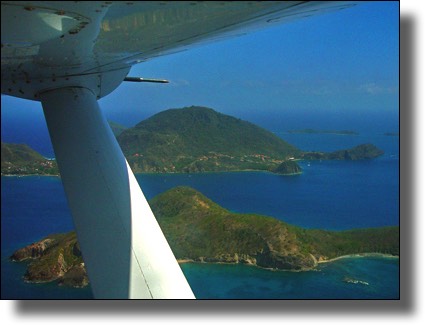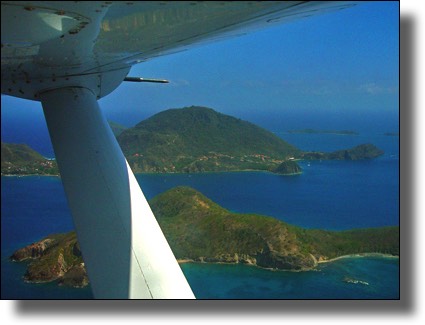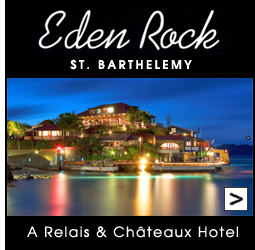Les Saintes, Guadeloupe - Description, Beaches, History
Just 10 km (6 mi) south of Guadeloupe, these idyllic tropical jewels float like exotic dreams in the Caribbean sea. Of the eight little islands, only two are inhabited, and picturesque Terre-de-Haut is the one travelers visit first. In addition to superb beaches, gorgeous bays, exceptional snorkeling and fascinating historical sites, this romantic island offers a charming village with excellent restaurants, interesting shops and unique art galleries. The other populated island, peaceful Terre-de-Bas, is only a few minutes by boat from Terre-de-Haut and is definitely worth a visit.

Les Saintes (also known as Iles des Saintes) are perfect for the kind of traveler who relishes unspoiled tropical beauty and the serenity that comes from doing next to nothing on a vacation, but doing it à la française. While Guadeloupe's bustling epicenter, Pointe-à-Pitre, is just a l5-minute charter plane hop or a short ferry ride away, it seems continents apart from the eight pristine volcanic dots that comprise Les Saintes. There are about 3,000 inhabitants in the islands, with more than half of them living on Terre-de-Haut, where the once ubiquitous motor scooters are being replaced by electric vehicles (golf carts and scooters) for cleaner air and quieter streets. The original doctor's home, designed to resemble a ship's bow, is something of a local landmark.
Terre-de-Haut is a very small island, less than 3 sq. miles (7.8 sq km) in size. The five-minute walk from the airstrip to Bourg, the island's only village, takes you down a bougainvillea-shaded lane lined with tiny brightly-painted houses and past a centuries-old cemetery. The names engraved upon the weathered headstones reflect the island's Breton and Norman ancestry; the conch shells decorating the graveyard honor its sailors lost at sea.
The men of Iles des Saintes are fishermen, reputedly the best in the West Indies, and watching them haul in their filets bleus (blue nets dotted with burnt-orange buoys) can fill an entire morning. On Bourg's main street you may still see a local resident or two wearing traditional headgear, a flat straw or bamboo platter covered with cloth called a salako. It is patterned after one said to have been brought here ages ago by a seafarer from China or Indonesia. Whatever its origin, the salako provides great sun protection and is unique to these islands.
As you travel around Les Saintes, you may spot iguanas on the ground or in the trees. These fascinating creatures are protected by law in these islands. They are fun to watch and photograph but, if you approach them, they will generally scramble quickly to another location. Please do not try to corner or handle them in any way. Iguanas have lots of dangerous little teeth, strong jaws and razor-sharp claws.
Les Saintes are dependency islands of Guadeloupe, which in turn is an Overseas Départment and Region of France. A mayor and town council oversee the day-to-day operations of the island.
BEACHES
Sensational beaches are easy to find in Les Saintes. On Terre-de-Haut, Plage Pompierre is the most popular beach with its calm waters, excellent snorkeling and covered picnic tables. The small beach at Pain de Sucre is also a favorite with visitors for swimming and snorkeling.
Plage Crawen, near the Bois Joli Hôtel, was formerly an official plage naturiste (clothing-optional beach), but the local politics have changed that. At the end of the airport runway, Grande Anse is a magnificent arc of sand but is definitely not safe for swimming. However, on Terre-de-Bas, a second Grande Anse is considered one of the best beaches in Les Saintes.
A BRIEF HISTORY
The history of Les Saintes is as rich as their cuisine. Columbus spied these islands on November 4, 1493, three days after the Feast of All Saints. He named the archipelago Los Santos, which was later revised by the French to Les Saintes. (Every November 1, Les Saintois observe All Saints Day (Toussaint) by illuminating their cemeteries with a profusion of candles.)
The first French settlers ventured here in the mid-l7th century, and the neighboring seas subsequently served as the battleground for many a skirmish with the British. One of the most famous, the great naval battle of l782 between Admirals Rodney and de Grasse, was fought in the channel of Les Saintes, and resulted in three decades of British rule. The Saints were returned to the French through the Treaty of Paris in 1815.
Some of the history is recalled in Terre-de-Haut's most important annual event, La Fête des Saintes, a two-day affair celebrated every August. On August 15, it commemorates the first expulsion of British invaders in l666 and on August 16, it honors the Virgin Mary and all local sailors ever lost at sea. There are speeches and parades, a blessing of boats and ribbon-cutting for various enterprises related to fishing and the sea, which support the bulk of the island's economy. It is also, of course, a time for wining, dining, and dancing. But because Terre-de-Haut is so small and its festival so popular, these two days in August are best left for the locals to enjoy by themselves, or with visiting relatives and yachtsmen from nearby islands.
Terre-de-Haut is a very small island, less than 3 sq. miles (7.8 sq km) in size. The five-minute walk from the airstrip to Bourg, the island's only village, takes you down a bougainvillea-shaded lane lined with tiny brightly-painted houses and past a centuries-old cemetery. The names engraved upon the weathered headstones reflect the island's Breton and Norman ancestry; the conch shells decorating the graveyard honor its sailors lost at sea.
The men of Iles des Saintes are fishermen, reputedly the best in the West Indies, and watching them haul in their filets bleus (blue nets dotted with burnt-orange buoys) can fill an entire morning. On Bourg's main street you may still see a local resident or two wearing traditional headgear, a flat straw or bamboo platter covered with cloth called a salako. It is patterned after one said to have been brought here ages ago by a seafarer from China or Indonesia. Whatever its origin, the salako provides great sun protection and is unique to these islands.
As you travel around Les Saintes, you may spot iguanas on the ground or in the trees. These fascinating creatures are protected by law in these islands. They are fun to watch and photograph but, if you approach them, they will generally scramble quickly to another location. Please do not try to corner or handle them in any way. Iguanas have lots of dangerous little teeth, strong jaws and razor-sharp claws.
Les Saintes are dependency islands of Guadeloupe, which in turn is an Overseas Départment and Region of France. A mayor and town council oversee the day-to-day operations of the island.
BEACHES
Sensational beaches are easy to find in Les Saintes. On Terre-de-Haut, Plage Pompierre is the most popular beach with its calm waters, excellent snorkeling and covered picnic tables. The small beach at Pain de Sucre is also a favorite with visitors for swimming and snorkeling.
Plage Crawen, near the Bois Joli Hôtel, was formerly an official plage naturiste (clothing-optional beach), but the local politics have changed that. At the end of the airport runway, Grande Anse is a magnificent arc of sand but is definitely not safe for swimming. However, on Terre-de-Bas, a second Grande Anse is considered one of the best beaches in Les Saintes.
A BRIEF HISTORY
The history of Les Saintes is as rich as their cuisine. Columbus spied these islands on November 4, 1493, three days after the Feast of All Saints. He named the archipelago Los Santos, which was later revised by the French to Les Saintes. (Every November 1, Les Saintois observe All Saints Day (Toussaint) by illuminating their cemeteries with a profusion of candles.)
The first French settlers ventured here in the mid-l7th century, and the neighboring seas subsequently served as the battleground for many a skirmish with the British. One of the most famous, the great naval battle of l782 between Admirals Rodney and de Grasse, was fought in the channel of Les Saintes, and resulted in three decades of British rule. The Saints were returned to the French through the Treaty of Paris in 1815.
Some of the history is recalled in Terre-de-Haut's most important annual event, La Fête des Saintes, a two-day affair celebrated every August. On August 15, it commemorates the first expulsion of British invaders in l666 and on August 16, it honors the Virgin Mary and all local sailors ever lost at sea. There are speeches and parades, a blessing of boats and ribbon-cutting for various enterprises related to fishing and the sea, which support the bulk of the island's economy. It is also, of course, a time for wining, dining, and dancing. But because Terre-de-Haut is so small and its festival so popular, these two days in August are best left for the locals to enjoy by themselves, or with visiting relatives and yachtsmen from nearby islands.

Les Saintes (also known as Iles des Saintes) are perfect for the kind of traveler who relishes unspoiled tropical beauty and the serenity that comes from doing next to nothing on a vacation, but doing it à la française. While Guadeloupe's bustling epicenter, Pointe-à-Pitre, is just a l5-minute charter plane hop or a short ferry ride away, it seems continents apart from the eight pristine volcanic dots that comprise Les Saintes. There are about 3,000 inhabitants in the islands, with more than half of them living on Terre-de-Haut, where the once ubiquitous motor scooters are being replaced by electric vehicles (golf carts and scooters) for cleaner air and quieter streets. The original doctor's home, designed to resemble a ship's bow, is something of a local landmark.
Terre-de-Haut is a very small island, less than 3 sq. miles (7.8 sq km) in size. The five-minute walk from the airstrip to Bourg, the island's only village, takes you down a bougainvillea-shaded lane lined with tiny brightly-painted houses and past a centuries-old cemetery. The names engraved upon the weathered headstones reflect the island's Breton and Norman ancestry; the conch shells decorating the graveyard honor its sailors lost at sea.
The men of Iles des Saintes are fishermen, reputedly the best in the West Indies, and watching them haul in their filets bleus (blue nets dotted with burnt-orange buoys) can fill an entire morning. On Bourg's main street you may still see a local resident or two wearing traditional headgear, a flat straw or bamboo platter covered with cloth called a salako. It is patterned after one said to have been brought here ages ago by a seafarer from China or Indonesia. Whatever its origin, the salako provides great sun protection and is unique to these islands.
As you travel around Les Saintes, you may spot iguanas on the ground or in the trees. These fascinating creatures are protected by law in these islands. They are fun to watch and photograph but, if you approach them, they will generally scramble quickly to another location. Please do not try to corner or handle them in any way. Iguanas have lots of dangerous little teeth, strong jaws and razor-sharp claws.
Les Saintes are dependency islands of Guadeloupe, which in turn is an Overseas Départment and Region of France. A mayor and town council oversee the day-to-day operations of the island.
BEACHES
Sensational beaches are easy to find in Les Saintes. On Terre-de-Haut, Plage Pompierre is the most popular beach with its calm waters, excellent snorkeling and covered picnic tables. The small beach at Pain de Sucre is also a favorite with visitors for swimming and snorkeling.
Plage Crawen, near the Bois Joli Hôtel, was formerly an official plage naturiste (clothing-optional beach), but the local politics have changed that. At the end of the airport runway, Grande Anse is a magnificent arc of sand but is definitely not safe for swimming. However, on Terre-de-Bas, a second Grande Anse is considered one of the best beaches in Les Saintes.
A BRIEF HISTORY
The history of Les Saintes is as rich as their cuisine. Columbus spied these islands on November 4, 1493, three days after the Feast of All Saints. He named the archipelago Los Santos, which was later revised by the French to Les Saintes. (Every November 1, Les Saintois observe All Saints Day (Toussaint) by illuminating their cemeteries with a profusion of candles.)
The first French settlers ventured here in the mid-l7th century, and the neighboring seas subsequently served as the battleground for many a skirmish with the British. One of the most famous, the great naval battle of l782 between Admirals Rodney and de Grasse, was fought in the channel of Les Saintes, and resulted in three decades of British rule. The Saints were returned to the French through the Treaty of Paris in 1815.
Some of the history is recalled in Terre-de-Haut's most important annual event, La Fête des Saintes, a two-day affair celebrated every August. On August 15, it commemorates the first expulsion of British invaders in l666 and on August 16, it honors the Virgin Mary and all local sailors ever lost at sea. There are speeches and parades, a blessing of boats and ribbon-cutting for various enterprises related to fishing and the sea, which support the bulk of the island's economy. It is also, of course, a time for wining, dining, and dancing. But because Terre-de-Haut is so small and its festival so popular, these two days in August are best left for the locals to enjoy by themselves, or with visiting relatives and yachtsmen from nearby islands.
________________________________________
French Caribbean International has been the premier guide to the French West Indies since 1994. We provide a wealth of helpful travel information for visitors to the Caribbean islands of St. Barthélemy (St. Barts, St. Barth, St. Barths), St. Martin / St. Maarten, Martinique, Guadeloupe, Les Saintes and Marie-Galante.







